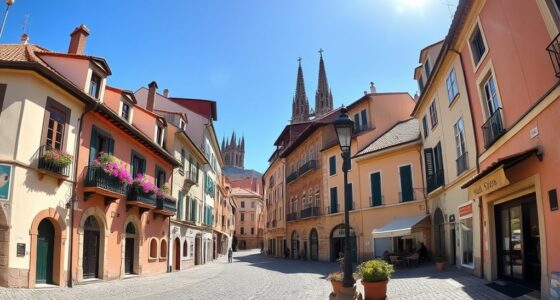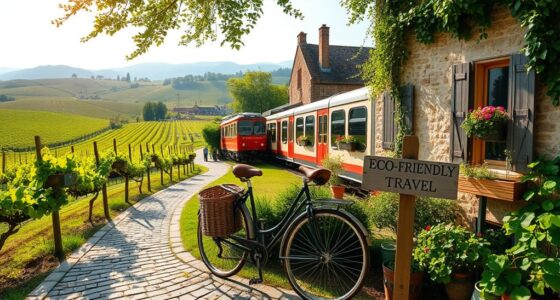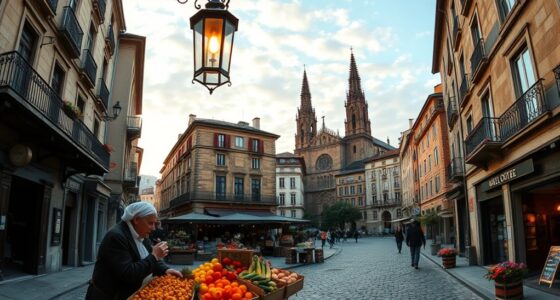European cuisines showcase a rich mix of regional flavors, ingredients, and cooking styles shaped by history and geography. From France’s refined dishes to Italy’s pasta and Spain’s tapas, each country has unique traditions and staples like grains, dairy, and fresh produce. Over centuries, influences from trade, empires, and religious practices have evolved these foods. To discover how these culinary traditions blend history with modern trends, explore further—you’ll find plenty of fascinating stories behind Europe’s diverse foodways.
Key Takeaways
- Europe’s diverse cuisines are shaped by regional ingredients, techniques, and historical influences, from French sauces to Italian pasta.
- Traditional meal structures often include multiple courses, communal dining, and specific customs reflecting regional cultural heritage.
- Staple ingredients like grains, dairy, herbs, and regional specialties define the unique flavors across European cuisines.
- Culinary heritage is preserved through traditional recipes, festivals, and local markets, balancing authenticity with modern innovation.
- Contemporary trends emphasize sustainability, local sourcing, fusion, and innovative techniques while respecting culinary traditions.
The Regional Diversity of European Cuisines
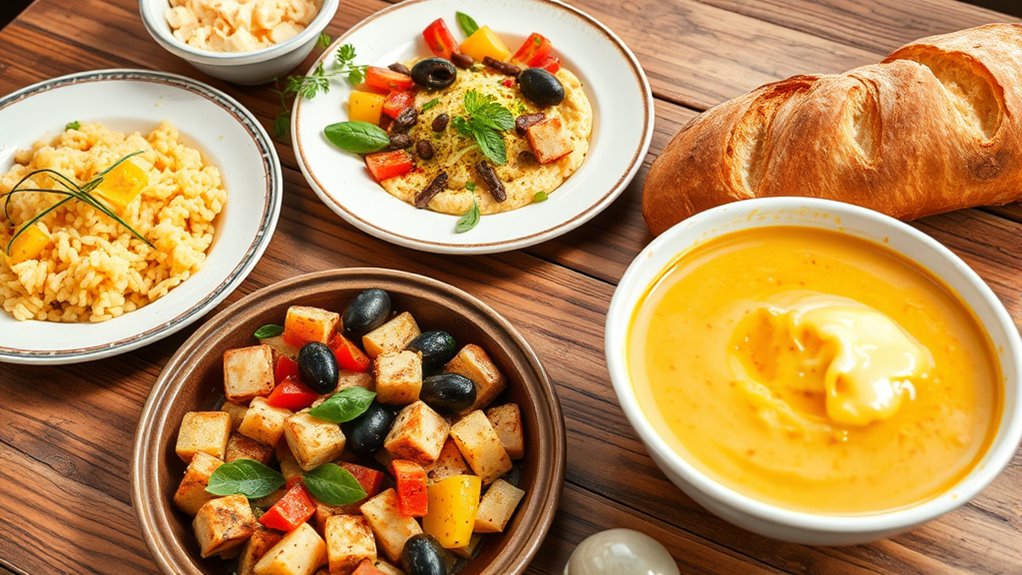
Europe’s diverse geography and history have shaped a rich tapestry of regional cuisines, each with its unique ingredients, techniques, and flavors. In France, you’ll find an emphasis on fresh, locally sourced ingredients and sophisticated techniques like braising and sautéing, creating dishes such as coq au vin and ratatouille. Italy’s cuisine varies by region but generally features pasta, pizza, and risotto flavored with olive oil, garlic, and herbs. Spain’s bold flavors shine in dishes like paella and tapas, utilizing saffron, smoked paprika, and jamón ibérico. Eastern European cuisines focus on hearty, comforting foods like pierogi and goulash, often incorporating potatoes, cabbage, and sour cream. Meanwhile, Nordic countries showcase smoked fish, meatballs, and pickled vegetables, reflecting their cooler climate and abundant natural resources.
Historical Influences Shaping European Foodways
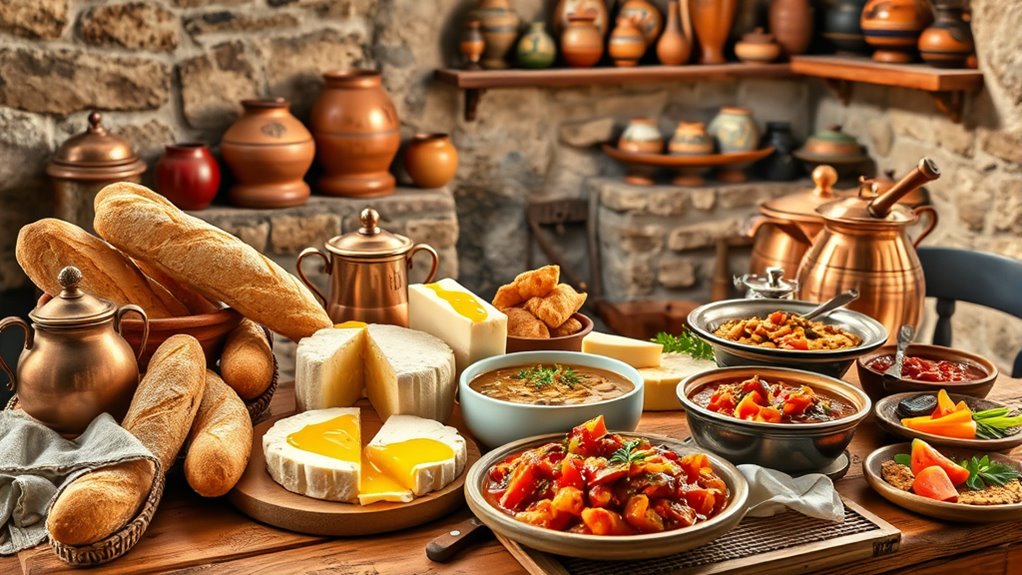
Historical events and societal changes have profoundly shaped European foodways, influencing both ingredients and culinary practices. You see, class distinctions once dictated what you could eat, with luxurious ingredients reserved for the wealthy and simpler fare for common folks. Trade routes introduced new spices, vegetables, and grains—think tomatoes, potatoes, and maize—transforming traditional diets. The Ottoman and Austro-Hungarian empires brought spices and cooking techniques that blended cultures, evident in dishes like goulash. Religious traditions also played a role, dictating fasting periods and festive foods. Preservation methods such as salting, drying, and smoking persisted until refrigeration evolved. Additionally, the adoption of luxurious materials in kitchenware and dining ware further elevated the dining experience, reflecting the influence of societal status on culinary presentation. These historical influences collectively shaped Europe’s diverse culinary landscape, giving you a rich tapestry of flavors, techniques, and customs that continue to influence modern European cuisine.
Key Ingredients and Staples Across Europe
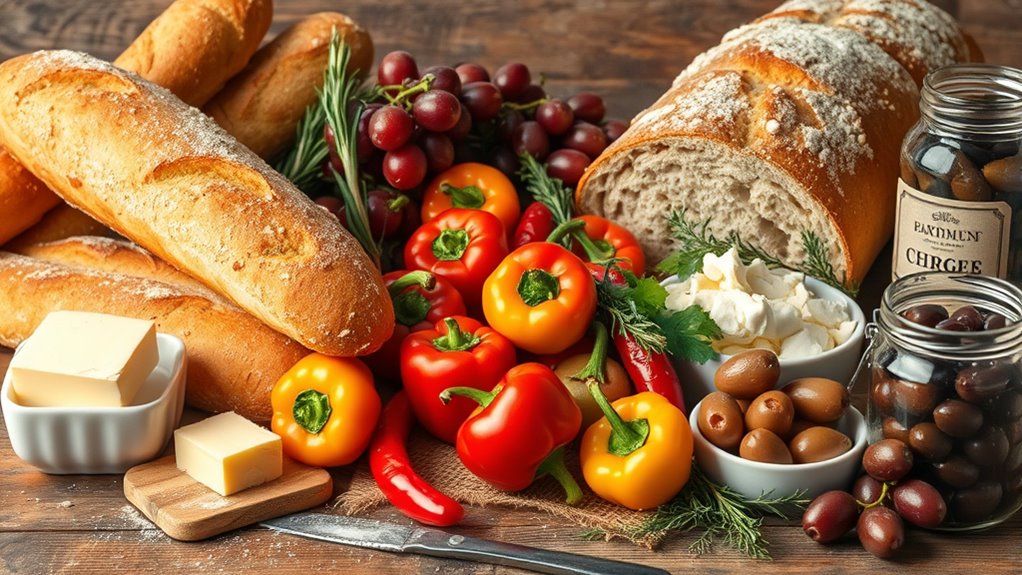
You’ll notice that Europe’s cuisines rely heavily on staple grains like wheat, rye, and barley for bread, noodles, and dumplings. Regional dairy products such as cheese, sour cream, and yogurt also play a vital role in many dishes. These ingredients form the foundation of countless recipes that define each area’s culinary identity. Additionally, many European countries utilize self watering plant pots to maintain fresh herbs and delicate plants used in traditional cooking.
Staple Grain Varieties
Grains serve as the foundation of many European dishes, providing sustenance and flavor across diverse regions. You’ll find wheat, rye, barley, rice, and oats playing key roles in daily meals. Wheat is essential for bread, pasta, and pastries, especially in France and Italy. Rye dominates in Northern and Eastern Europe, used for hearty bread like pumpernickel. Barley appears in soups, stews, and brewing traditions. Rice is central in Mediterranean and Iberian cuisines, like risotto and paella. Oats are common in breakfast dishes and porridge across Scandinavia. These grains adapt to regional flavors and methods, shaping the culinary landscape. Different grains are often processed using traditional methods unique to each region, reflecting local culture and history.
Regional Dairy Products
Have you ever noticed how dairy products define the flavors and textures of European cuisine? From creamy cheeses to tangy yogurts, dairy plays a crucial role across regions. In France, you savor cheeses like Brie, Camembert, and Roquefort, often paired with bread and wine. Italy boasts rich ricotta, Parmesan, and mozzarella, essential for pasta and pizza. In Spain, manchego cheese offers sharp, nutty notes, while cured meats are often served with fresh cheese. Eastern Europe features sour cream and curd cheeses that add creaminess to hearty dishes like pierogi and goulash. Nordic countries excel with smoked salmon and butter, used in bread and salads. These dairy staples not only enhance flavors but also reflect regional climates and agricultural traditions. Minimalism in presentation allows the natural qualities of these dairy products to stand out, highlighting their simplicity and authenticity.
Traditional Meal Structures and Dining Customs
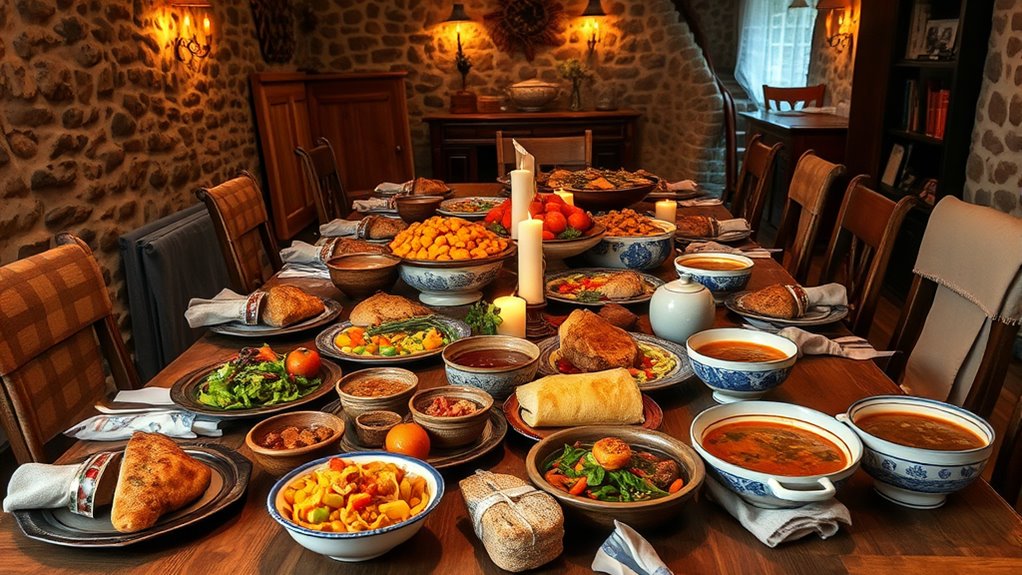
Traditional meal structures in Europe often follow a formal sequence that emphasizes a clear separation of courses, reflecting both historical influences and cultural values. You’ll typically start with appetizers or hors d’oeuvres, followed by soups or salads, then the main course. Dessert concludes the meal, with sweet and savory dishes kept distinct. Service styles vary by region: Nordic countries favor buffets, while Spain’s tapas encourage sharing small plates. Cutlery has evolved from knives alone to include forks, with most dishes eaten using utensils. Sharing meals, family-style servings, and festive banquets are common, especially in Eastern and Southern Europe. Historically, upper classes enjoyed elaborate dishes, while regional cuisines developed through tradition and social structure. This structured approach underscores Europe’s rich culinary heritage. Implementing designated zones for specific courses or activities can help maintain the orderliness of traditional European dining customs.
Iconic Dishes and National Specialties
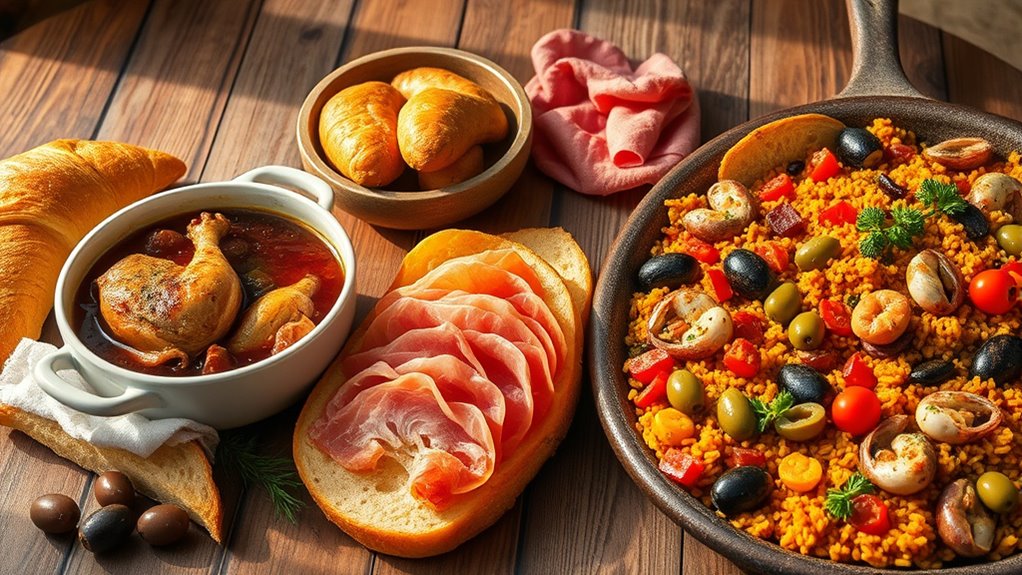
Europe’s diverse culinary landscape is best highlighted by its iconic dishes and national specialties, which reflect each region’s unique history, ingredients, and cultural influences. In France, you find coq au vin, bouillabaisse, and ratatouille, showcasing sophisticated techniques and fresh ingredients. Italy’s staples include lasagna, pizza Margherita, and risotto alla Milanese, emphasizing regional produce and simple flavors. Spain offers paella, gazpacho, and tortilla española, known for bold spices and communal eating. Eastern Europe features hearty goulash, pierogi, and borscht, reflecting comfort and tradition. The Nordic countries present gravlaks, meatballs, and smørrebrød, highlighting preservation methods and local seafood. These dishes embody each nation’s history, ingredients, and culinary identity, creating a rich tapestry of flavors across Europe. Additionally, some regions are gaining recognition for innovative culinary experiences, such as unique tasting experiences that emphasize regional flavors and traditions.
Modern Trends and the Impact of Globalization
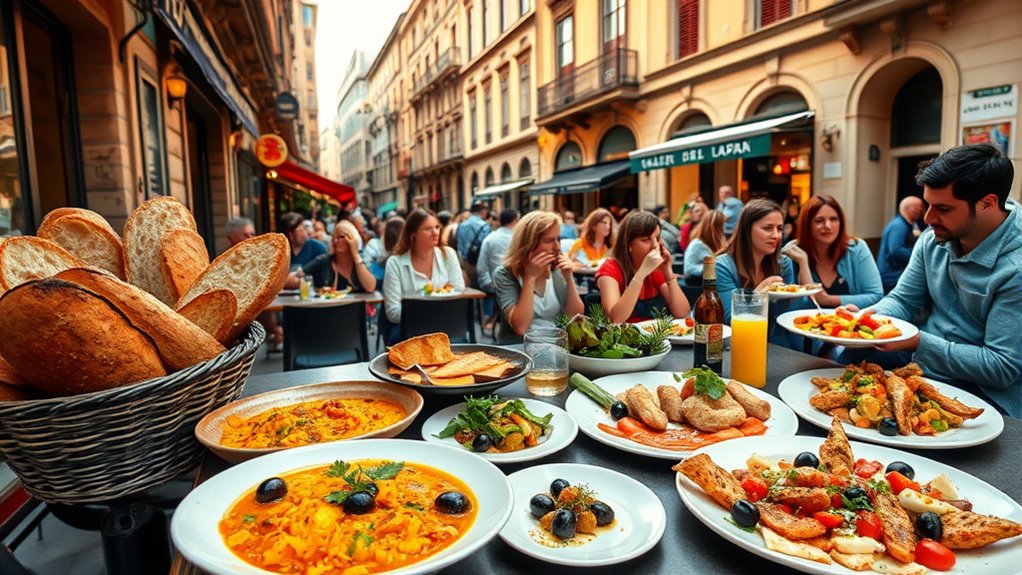
Modern culinary trends are reshaping Europe’s rich food landscape by emphasizing local sourcing, seasonal ingredients, and sustainable practices. You’ll notice chefs prioritizing organic produce from nearby farms and reducing food waste. Fusion cuisines are gaining popularity as traditional recipes blend with global flavors, creating innovative dishes. Fast food adapts regional favorites like pizza and croissants, making them accessible worldwide. Many regions preserve centuries-old recipes and food markets, maintaining cultural authenticity amid change. Tourism boosts interest in local specialties, encouraging culinary exploration. These trends foster a more conscious approach to food, supporting local economies and environmental health. Additionally, current news in Indonesia highlights how regional food traditions are evolving in response to global influences, reflecting a broader shift towards sustainability and cultural preservation in culinary practices.
Preserving Heritage and Culinary Innovation
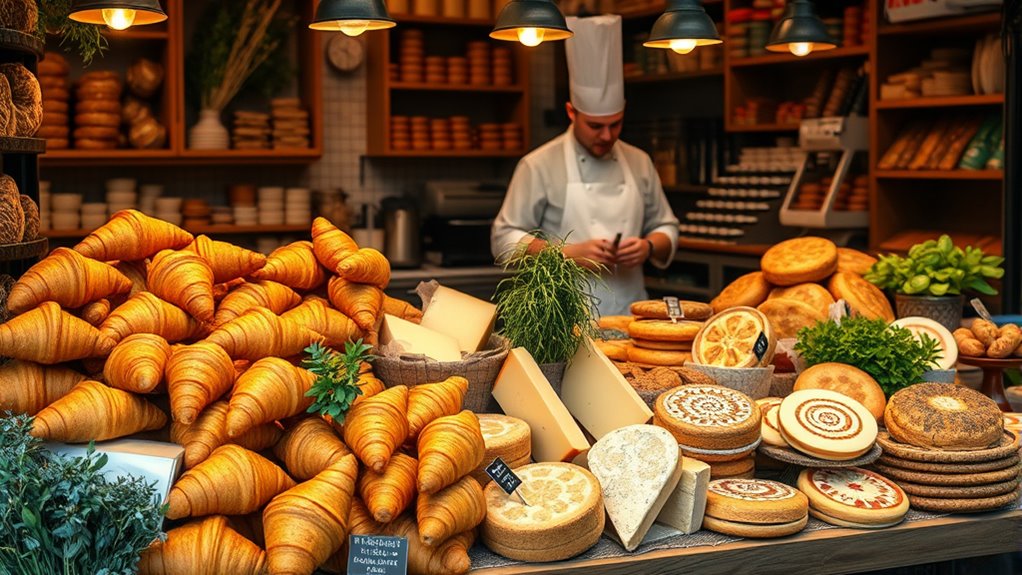
Preserving culinary heritage while embracing innovation is essential for maintaining Europe’s rich food identity. You can do this by keeping traditional recipes alive through family and community practices, food festivals, and local markets. Chefs and home cooks experiment with modern techniques like sous vide or molecular gastronomy, adding new twists without losing authenticity. Supporting regional producers helps sustain local ingredients and customs. Documenting recipes and culinary stories preserves their cultural significance. At the same time, blending old flavors with global influences creates exciting new dishes that honor tradition. This balance ensures Europe’s diverse culinary landscape remains vibrant, relevant, and true to its roots. By valuing history and welcoming change, you help keep Europe’s culinary legacy alive for future generations. Incorporating cultural heritage into contemporary cuisine further enriches this ongoing dialogue between tradition and innovation.
Frequently Asked Questions
How Do European Cuisines Vary Between Urban and Rural Areas?
You’ll notice that in urban areas, European cuisines often incorporate more global influences, trendy ingredients, and modern techniques, catering to diverse tastes. In contrast, rural regions rely on traditional, locally sourced ingredients, emphasizing hearty, simple dishes rooted in history. You might find rural recipes passed down through generations, while cities experiment with fusion and contemporary styles. This contrast reflects the blend of tradition and innovation shaping European food culture across different settings.
What Role Do Seasonal Festivals Play in Culinary Traditions?
You’ll find seasonal festivals deeply influence European culinary traditions by celebrating harvests, religious events, and cultural heritage. These festivals often feature special dishes, sweets, and drinks that highlight local ingredients and traditional recipes. You participate in communal cooking, sharing, and tasting during these times, which strengthens local identity. They also inspire new culinary innovations while preserving age-old techniques, making your food experience richer and more meaningful throughout the year.
How Have Immigration Patterns Influenced Regional European Dishes?
Like a tapestry woven with new threads, immigration has enriched your regional dishes with diverse flavors. You’ll find Mediterranean olives in Northern European stews, spicy Asian spices in Eastern European sausages, and Latin American ingredients in French fusion cuisine. These influences blend history and culture, transforming traditional recipes into innovative creations. Embrace this culinary evolution, knowing it reflects Europe’s open-hearted embrace of new ideas and shared gastronomic adventures.
What Are Common Dietary Restrictions and Their Cultural Significance?
You’ll find that common dietary restrictions in Europe often stem from religious, cultural, or health beliefs. For example, Jews keep kosher, avoiding pork and mixing dairy with meat, reflecting spiritual laws. Muslims avoid pork and alcohol, emphasizing faith. Catholics may fast or abstain during Lent, showing devotion. These restrictions shape menus, foster cultural identity, and influence traditional celebrations, highlighting the deep connection between food practices and cultural values across the continent.
How Do European Countries Approach Sustainable and Organic Farming?
You see, European countries are weaving sustainability into their farming tapestry like artisans crafting a masterpiece. They prioritize organic methods, supporting local farmers and reducing chemical use. Policies encourage green practices, from crop rotation to preserving biodiversity. People embrace farmers’ markets and farm-to-table movements, turning their plates into a canvas of eco-conscious choices. This approach nurtures the land, ensuring future generations can savor the flavors of Europe’s rich culinary landscape.
Conclusion
As you explore Europe’s diverse cuisines, you might wonder if its rich culinary tapestry truly reflects centuries of history and cultural exchange. The theory that European food evolved solely from local traditions is challenged by the undeniable influence of trade, conquest, and migration. Embracing both heritage and innovation, you can appreciate how Europe’s culinary landscape continues to evolve, blending ancient flavors with modern trends to create a vibrant, ever-changing food culture worth celebrating.



